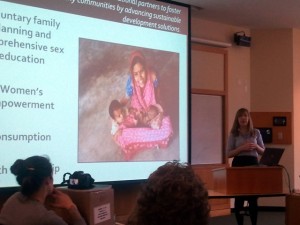Ties that Bind: Making the Population and Environment Connection
Mar 9th, 2012 | By admin | Category: Other ResourcesBy Suzanne York, HowMany.org, March 8, 2012
 The Public Interest Environmental Law Conference took place this past weekend (March 2-4) in Eugene, Oregon. If you’re not familiar with it, it is an [inspiring] gathering of environmentalists of all stripes and professions that has been taking place for thirty years.
The Public Interest Environmental Law Conference took place this past weekend (March 2-4) in Eugene, Oregon. If you’re not familiar with it, it is an [inspiring] gathering of environmentalists of all stripes and professions that has been taking place for thirty years.
This year I attended for the first time, and the workshop highlight for me was the Population and the Environment Movement panel. How can we deal with all the critical issues facing the planet if we don’t address population? The theme was on the absence of most environmental groups from the population growth discussion, and how to move this critical topic to the environmental table, while also recognizing the need to link it to social justice and reproductive health.
This workshop had an all-woman panel of environmental activists. It was great to see these females leaders talking about the many issues relating to population growth. Hopefully the next time it will also include some people of color – male or female – but nevertheless this was a powerful panel.
Amy Harwood of the Center for Biological Diversity led off the workshop, saying sooner or later environmentalists will be forced to seriously address the links between population and the environment. Talking about population and climate change is one way to bring more people into this conversation. However the topic is approached, it should be framed around choice and that we should all be able to choose the world we live in.
Veteran population justice advocate Laurie Mazur told the crowd of nearly 70 attendees that there are 3 billion people under the age of 25, the largest generation of people coming of age the world has ever seen. All 7 billion of us live in a society of inequitable use of resources and distribution/access. Moreover, two-thirds of natural resources are used unsustainably. If we are to come to terms with scarce resources and all forms of inequality, there must be a recognition of an inalienable right to resources in order to have healthy families and ecosystems. And governments need to invest more in family planning, providing people the means and the power to make choices and decisions impacting their families.
Kim Lovell, of the Sierra Club’s Global Population and Environment Program, discussed how her organization’s approach to population and environment issues focuses on access to voluntary family planning, comprehensive sex education, awareness of consumption levels, women’s empowerment, and fostering youth leadership. A big part of the work is on how to use resources more equitably. According to recent research, 8 in 10 environmentalists want to see population addressed along with consumption and developing renewable energy.
Lisa Hymas of the online environmental website Grist presented a perspective on media coverage of population issues (or rather, lack of coverage). Except for the times when another billion person milestone is achieved, there is little media on the links between population and the environment. However, population could and should be part of many news stories today, from climate change to democracy movements. There is an all-too-common view that we are running out of people or that lowering population levels are bad.
Education, choice, awareness and justice were key themes of the panel. To have success, the movement should build on a framework of justice – social, environmental, and economic. And within that truly confront the consumption factor. Unsustainable consumption has been acknowledged as a main driver of environmental degradation for decades now, but not much has been accomplished to overcome it. Actions on alternatives measures of Gross Domestic Product (GDP) and economic growth are gaining traction and should be part of any discussion on the issues of global population and the environment.
Ultimately, the panelists talked about things we all should be doing and supporting anyway, to improve lives and safeguard our environment.
Suzanne York is a senior writer with the Institute for Population Studies/HowMany.org.
